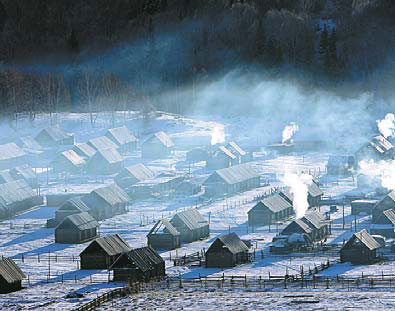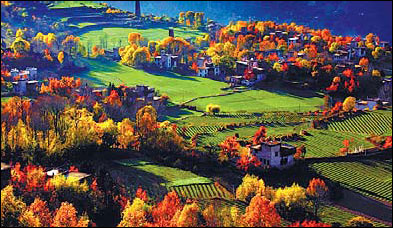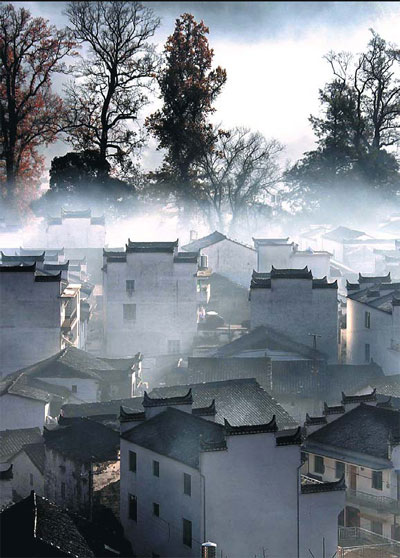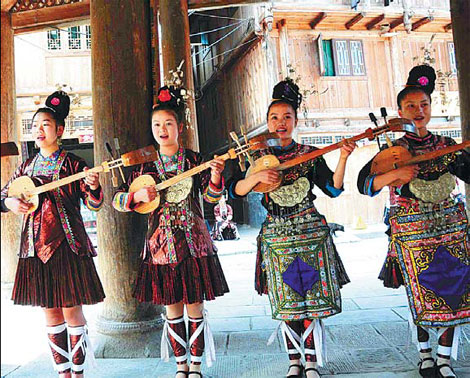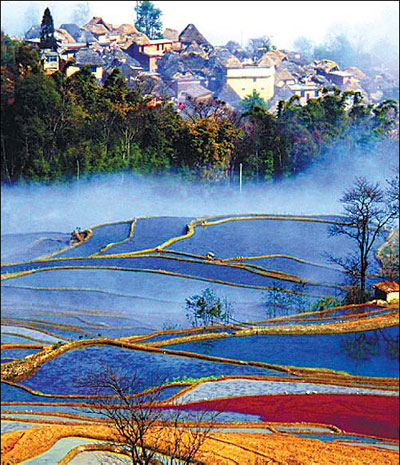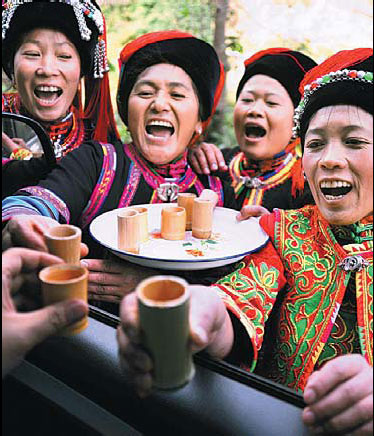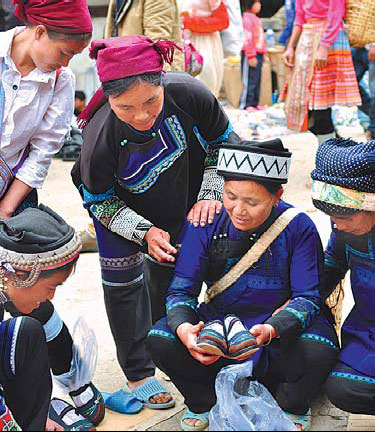Small but perfectly formed
Updated: 2013-01-01 07:53
By Deng Zhangyu (China Daily)
|
||||||||
While most visitors to China visit its mega cities, Deng Zhangyu finds that those who get off the beaten track will find tourist gold in the country's most beautiful villages.
The hustle and bustle of cities sometimes numbs us to our surroundings, so why not travel a fresh path in 2013 and savor the countryside?
The country's scattered villages all have their unique charms and to help you get in touch with nature and tranquility here are five of the best.
|
Tuwa villages are covered in a blanket of early winter snow. Zhang Wencheng / For China Daily |
1. Altay, Xinjiang Uygur autonomous region
Wooden houses fence in cows and sheep, pine trees stand in rows not far away from the hillside and smoke spirals from kitchen chimneys.
Tuwa villages along the Kanas River in Altay county in Xinjiang Uygur autonomous region have oft been described in terms of a fantasyland.
The Tuwa are a nomadic tribe and said to be related to the Mongolians. For 400 years they have settled along the Kanas River, dubbed "the last piece of pure land on Earth".
They are good at horse riding, singing and dancing. The villages and their people still live old-style lives.
The best time to visit is from June to September, when the land is bathed in yellow hues.
If you go
Fly to Urumqi, the capital of Xinjiang Uygur autonomous region. Then take a minibus to Altay county or Burqin county, costing about 80 yuan ($13) per person. The Kanas River is 140 km away from Burqin county and 200 km from Altay. Visitors have to rent a car or taxi. Hotels cost about 200 yuan and a yurt costing 350 yuan can house eight to 10 people.
|
Danba is one of China's top scenic attractions during autumn. Shen Haibin / For China Daily |
2. Danba, Sichuan province
The Tibetan villages in Danba county, Sichuan province, feature ancient watchtowers, ridges and peaks, and unique Tibetan culture.
Located in the east of Garze Tibetan autonomous prefecture, Danba is perched on a 2,500-meter-high mountainside, surrounded by steep green hills and dotted with villages in a valley along the Dadu River.
There are about 200 traditional stone houses nestled on mountains in Jiaju, 7 km northwest of Danba, surrounded by endless forests, fields coated with blooming flowers and winding rivers.
It's just like a fairyland and women here have fair features and pale complexions, which is why Danba is called "Valley of Beauties".
The best season to visit is spring and autumn when the leaves change color.
If you go
Fly to Chengdu first and then take buses from Chengdu West Station to Danba county, about 10 hours' drive away. Renting a car or taxi to nearby villages costs about 200 yuan ($32) per day. Or you can take a minibus to villages 20 km from Danba. Hotels range in price from 150 to 300 yuan. Families in the villages offer home-stays for 60 yuan, which includes dinner and breakfast.
|
Village residences are shrouded in the early morning mist, in Wuyuan. Shi Guangde / For China Daily |
3. Wuyuan, Jiangxi province
Home to some of the most beautiful villages in China, Wuyuan is known for its traditional residential houses built up to 1,000 years ago.
Wuyuan, in northeast of Jingxi province, has more than 50 old villages and houses typically have white walls and are three-story buildings. Sculpted woodcarvings can be seen on the houses and best-preserved temples.
Villages like Likeng and Sixi are famous for their idyllic present and glorious past. They are home to top scholars, such as Zhuxi, the Confucius master from the Southern Song Dynasty (1127-1279). The county was also noted for producing rich merchants and top officials in ancient times.
The best time to visit is in March and April when the fields are covered by yellow rapeseed.
During this season, the mountains are aflame with azaleas, green tea trees dot the slopes of mountains and farmers drive their ducks to ponds. It is a countryside symphony.
If you go
Visitors need to fly to Jingdezhen in Jiangxi province, or Huangshan in Anhui province, and then take a one-hour bus ride to Wuyuan county. To explore more of the villages, visitors can either take a minibus or ride a bike. Tickets priced 180 yuan ($29) grant five-day entry to all scenic spots. The county has lots of hotels and villages offering simple and cheap accommodation costing less than 100 yuan per night.
|
Dong people are passionate about singing. Zhang Jing / For China Daily |
4. Zhaoxing, Guizhou province
Located in Liping county in Guizhou province, Zhaoxing is home to the ethnic Dong people and the country's largest Dong village.
Lying in a basin circled by mountains, the village boasts traditional wooden architecture, five drum towers, five carved bridges and five theater stages. The village is divided into five clans.
A river winds though the whole village. Standing along the river banks are rows of diaojiaolou, or suspended houses, over the water.
Most people here wear ethnic clothing decorated by silver ornaments and speak the Dong dialect.
After the mist fades and sunshine penetrates the village, Dong people begin their treks to the morning market.
You can find local snacks like rice balls and women carry their infants in baskets on their backs.
Dong people are good at singing and have a great passion for it, no matter the age.
If you go
Fly to Guiyang in Guizhou province. You can either choose to fly from Guiyang to Liping county (30 minutes, on Monday, Wednesday, Friday and Sunday), or take a nine-hour bus ride. To Zhaoxing Dong village, there are buses in the town. The accommodation and food are cheap. One night in a hotel costs just 50 yuan ($8).
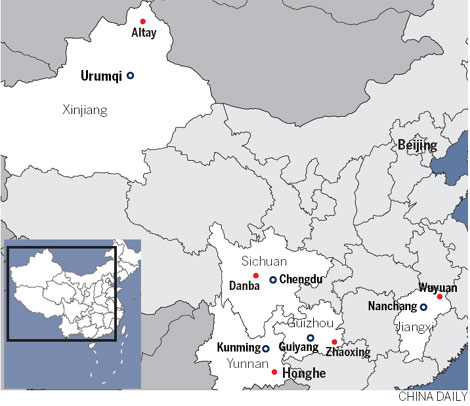
|
Rice terraces are a natural wonder created by the Hani people. Shen Haibin / For China Daily |
5. Hani, Yunnan province
Famous for its magnificent rice terraces, Hani village is well off the beaten track and showcases a place where man and nature live together in harmony.
Deep in southeastern Yunnan province, Hani village in Honghe Hani and Yi autonomous prefecture, is a mix of forest, cottages, terraces and rivers. Halfway down the steep Ailao Mountain, the rice terraces glitter in the sun.
Hani people have lived in the area for more than 1,300 years and still lead a traditional lifestyle.
The pace of life is slow and it is a perfect place for those looking for inner peace.
If you go
Take a bus in Kunming to Jianshui county, which takes about four hours. Then take a minibus to Yuanyang county and another bus to Honghe Hani. Visitors can rent a four-wheel vehicle to take a tour of the whole village, costing 50 yuan ($8) for half a day. Tickets for scenic spots cost from 10 to 30 yuan.
Contact the writer at dengzhangyu@chinadaily.com.cn.
|
Hani people greet visitors with homemade wine. Wang Ying / For China Daily |
|
A bustling morning market in Honghe. Dong Naide / For China Daily |
(China Daily 01/01/2013 page10)

 In Photos: 7.0-magnitude quake hits Sichuan
In Photos: 7.0-magnitude quake hits Sichuan
 Li Na on Time cover, makes influential 100 list
Li Na on Time cover, makes influential 100 list
 FBI releases photos of 2 Boston bombings suspects
FBI releases photos of 2 Boston bombings suspects
 World's wackiest hairstyles
World's wackiest hairstyles
 Sandstorms strike Northwest China
Sandstorms strike Northwest China
 Never-seen photos of Madonna on display
Never-seen photos of Madonna on display
 H7N9 outbreak linked to waterfowl migration
H7N9 outbreak linked to waterfowl migration
 Dozens feared dead in Texas plant blast
Dozens feared dead in Texas plant blast
Most Viewed
Editor's Picks

|

|

|

|

|

|
Today's Top News
Live report: 7.0-magnitude quake hits Sichuan, heavy casualties feared
Boston suspect cornered on boat
Cross-talk artist helps to spread the word
'Green' awareness levels drop in Beijing
Palace Museum spruces up
First couple on Time's list of most influential
H7N9 flu transmission studied
Trading channels 'need to broaden'
US Weekly

|

|
